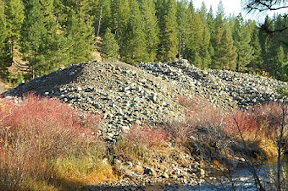We've always been fascinated by ghost towns. Seeing what remains today and trying to visualize what they looked liked in their heyday is always interesting, especially when you can read the history of the towns and find old photographs. We read about the town of Cornucopia, an old mining town, and decided to check it out.
On our way east to visit the town, we stopped at the Oregon Trail Visitors Center, a BLM facility that sits next to the trail and has a large interpretive center. Which, since it is a federal facility, was closed. We walked along the trail but didn't venture down to the wagon ruts themselves since the temperature was over 90 and the return would be a lengthy uphill walk. There was little to see without the center being open and the heat was fierce, so we decided to head for Cornucopia.
We followed the highway east from the visitor center as it followed a creek through canyons and desert until reaching the small town of Halfway. From there, we headed north on a dirt road into Cornucopia.
Cornucopia sits in a 4700' narrow valley surrounded by steep mountains on three sides. This is the "backside" of the Wallowa Mountains, a rugged, heavily forested area. Following the dirt road into the former townsite we saw what has become a typical "ghost town" - fallen remains of buildings, buildings barely standing, and others that have been fully or partially restored and are occupied during the summer.
 |
| Road to Cornucopia |
The town was named after a mine opened in 1884 and the successful mining of gold led to a population growth of around 700 residents by 1902. This was a tough place to live; the alpine environment meant extremely hard winters with snowfall measured in the tens of feet. Still, the mine continued to operate until 1929 when the stock market crashed, dropping the population to 10. It had a short revival when more efficient mining equipment was introduced, but WWII was a death knell for the town, and after over $4M in gold was extracted from the many tunnels under the town, the mine shut down.
 |
| Cornucopia Town Site |
Navigating over rough gravel and dirt roads, buildings became visible. Top left is what was probably a miner's dormitory, bottom left is the original jail, to the right a restored and occupied home.
A short distance from the town site is the Cornucopia Lodge and Pack Station, a modern lodge that serves as a starting point for those exploring the Eagle Cap Wilderness and for cross country skiing in the winter.
Besides lodging, it has a snack bar, large living area with fireplace, and the only WiFi in the area. We talked to the lady manager who told us that she and her husband live there year around. During the winter it sometimes resembles living in the lodge from "The Shining" but so far, without the ghosts. When asked how she could tolerate the snow and cold, she told us that she was from Stanley, ID, reputed to be the coldest town in the lower 48. We remember visiting there one summer - it was easy to tell which residents lived there year around; their stack of firewood was higher than the roofs of their houses!
Even though they stock up on supplies, they still have to make an occasional trip to Halfway. And it's only possible because of their really cool and appropriately named Yukon!
Our next stop was a week in amazing Joseph, a scenic town tucked into the northern side of the Wallowa Mountains. We'll be posting soon so check back!















